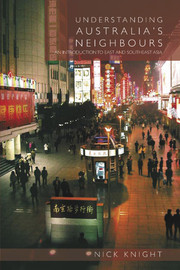Book contents
- Frontmatter
- Contents
- List of illustrations
- Acknowledgments
- Maps
- Introduction: Thinking about Asia, thinking about Australia
- 1 The Idea of ‘Asia’: Australia's ‘Near North’ – East and Southeast Asia
- 2 Tradition and Modernity in East and Southeast Asia: The family
- 3 Tradition and Modernity in East and Southeast Asia: Religion
- 4 Colonialism in East and Southeast Asia: How important was the impact of the West?
- 5 Nationalism and Revolution in East and Southeast Asia
- 6 Nations and Nation-Building in East and Southeast Asia
- 7 International Politics and East and Southeast Asia: The Cold War and the Sino-Soviet Split
- 8 The Rise and Decline of the Japanese Economic ‘Miracle’
- 9 The Newly Industrialising Economies of East and Southeast Asia: Economic growth and economic challenge
- 10 Democracy and Human Rights
- 11 Globalisation and East and Southeast Asia
- 12 Australia and Asia, ‘Asia’ in Australia
- Bibliography
- Index
- Plate section
- References
2 - Tradition and Modernity in East and Southeast Asia: The family
Published online by Cambridge University Press: 05 June 2012
- Frontmatter
- Contents
- List of illustrations
- Acknowledgments
- Maps
- Introduction: Thinking about Asia, thinking about Australia
- 1 The Idea of ‘Asia’: Australia's ‘Near North’ – East and Southeast Asia
- 2 Tradition and Modernity in East and Southeast Asia: The family
- 3 Tradition and Modernity in East and Southeast Asia: Religion
- 4 Colonialism in East and Southeast Asia: How important was the impact of the West?
- 5 Nationalism and Revolution in East and Southeast Asia
- 6 Nations and Nation-Building in East and Southeast Asia
- 7 International Politics and East and Southeast Asia: The Cold War and the Sino-Soviet Split
- 8 The Rise and Decline of the Japanese Economic ‘Miracle’
- 9 The Newly Industrialising Economies of East and Southeast Asia: Economic growth and economic challenge
- 10 Democracy and Human Rights
- 11 Globalisation and East and Southeast Asia
- 12 Australia and Asia, ‘Asia’ in Australia
- Bibliography
- Index
- Plate section
- References
Summary
the words most frequently encountered when studying Asia or listening to media reports on Asia are ‘tradition’ and ‘traditional’. One assumption is that we cannot understand Asia without knowing something about its traditions; another is that the influence of tradition in Asia remains particularly strong. It would seem from what we read in many scholarly and journalistic accounts that the influence of tradition is more powerful in Asian societies than it is in Western societies. There is often a sense that the ‘real’ Asia is the traditional Asia. The social and economic practices and institutions that have been imported from or heavily influenced by the West are not really ‘Asian’, regardless of how much they have been influenced by their Asian context. For example, an evening spent watching Beijing Opera would be seen by many as getting in touch with the ‘real’ China, the traditional China that existed before the West intervened and supposedly changed China. However, to go to a Beijing nightclub and dance to loud rock music under flashing lights would not be seen as particularly ‘Chinese’. Dress is another obvious example. ‘Tradition’ is often equated with forms of dress that are non-Western. We might not regard the Japanese executive's business suit as ‘traditional’, but we would the dress of the samurai or geisha. There are similar examples from all of the societies of East and Southeast Asia.
- Type
- Chapter
- Information
- Understanding Australia's NeighboursAn Introduction to East and Southeast Asia, pp. 22 - 39Publisher: Cambridge University PressPrint publication year: 2004



